
by Kate S. Zalzal Thursday, March 8, 2018
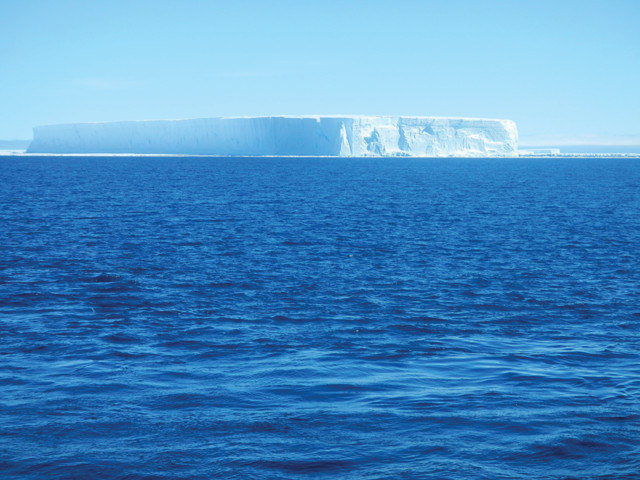
SOCCUM Project, Hannah Zanowski, CC BY 2.0
Seventy-one percent of our planet is covered by ocean, and these basins contain 97 percent of Earth’s near-surface water. The ocean lies at the heart of the global climate system, shaping all parts of our environment, even in the deepest continental interiors. So as the ocean goes, so goes the planet — and the ocean is warming.
Since the 1970s, just 7 percent of the heat associated with human-caused warming has gone to melting snow and ice or to warming the land surface and atmosphere. The remaining 93 percent of the heat has been absorbed by the ocean. Temperatures are increasing at nearly all latitudes and depths within the ocean. In 2016, both the global average atmospheric and sea-surface temperatures were the highest on record — the third consecutive year this milestone was reached — with sea-surface temperatures 0.75 degrees Celsius higher than the 20th-century average. And the warming trend is expected to continue, with mean global ocean temperatures predicted to increase by an additional 1 to 4 degrees Celsius by 2100.
The effect of this heat on the ocean, and what it means for the future, has gained widespread attention only in the last decade or so. Given the size of the ocean, and the time and cost associated with ship-based data acquisition, scientific understanding of many heat-related processes in the ocean has grown slowly, says Sarah Purkey, an oceanographer at Scripps Institution of Oceanography. But it’s clear that the ocean is changing. Sea level is rising, sea ice is melting, and ice shelves and glaciers are destabilizing. Ocean warming is also dramatically affecting marine biogeochemistry, with increases in deoxygenated dead zones and ocean acidification.
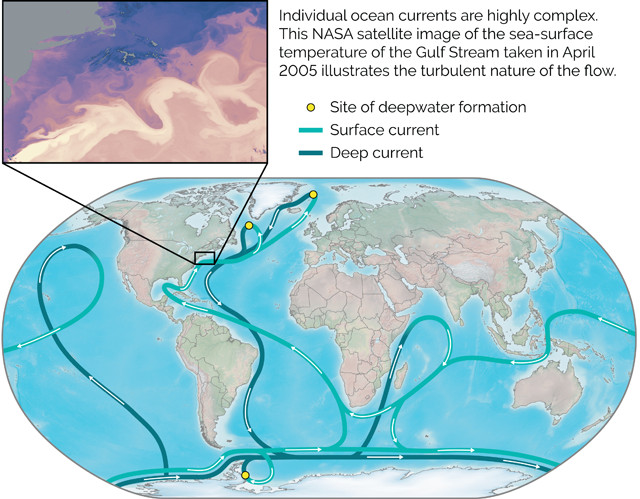
The stable pattern of global ocean circulation is known as meridional overturning circulation and is driven by density gradients that are strongly affected by changes in heat and freshwater input. Credit: K. Cantner, AGI.
As a heat and carbon reservoir for the world, the ocean has been a reliable buffer, largely shielding us from the worst effects of global warming. But this buffering capacity is not unlimited, and the warming may fundamentally alter our planet by disrupting how the ocean circulates. “We are seeing changes in the vital signs of the ocean,” says Anastasia Romanou, an oceanographer at Columbia University and NASA’s Goddard Institute for Space Studies. “This will impact nearly all aspects of the ocean,” she says.
Models suggest that warming will slow ocean circulation, especially meridional overturning circulation (MOC) — the global-scale ocean conveyor belt system that moves heat, carbon, oxygen and nutrients around the planet. While there is still much uncertainty about how this will play out, mounting evidence from the past decade indicates that warming is now reaching beneath the ocean surface and into even the deepest parts of the oceans, where it can impact the processes that drive ocean convection and deep circulation. “Based on changes in the structure of temperature, salinity and chlorofluorocarbons [a measure of ocean ventilation to the atmosphere] in the deep ocean, it looks like the MOC is slowing down,” Purkey says. This is problematic because the strength of the MOC — through its interaction with the atmosphere — determines the capacity of the ocean to absorb and store heat and carbon, and a slowdown could have far-reaching consequences for global climate and weather patterns, ocean currents, and marine ecosystems.
Earth’s modern large-scale ocean circulation patterns — which connect the surface and the deep ocean and move heat around the planet — developed beginning about 12,000 years ago, when melting of the great ice sheets of the last glacial period established our modern sea levels and coastlines.
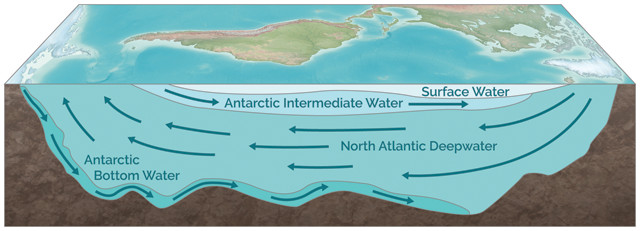
Starting at the surface in the Northern Hemisphere, surface waters chilled in the frigid Labrador and Nordic seas become denser and sink, forming North Atlantic Deepwater. At the bottom of the North Atlantic, this water mass turns south, flowing at depth above north-flowing Antarctic Bottom Water (AABW), for approximately 100 years until it meets the waters around Antarctica. Credit: K. Cantner, AGI.
Ocean currents circle the planet both at the surface and at depth, driven by wind, tides and water density differences, and further steered by ocean basin geography and Earth’s rotation.
Starting at the surface in the Northern Hemisphere, surface waters chilled in the frigid Labrador and Nordic seas become denser and sink, forming North Atlantic Deepwater (NADW). At the bottom of the North Atlantic, this water mass turns south, flowing at depth for approximately 100 years until it meets the Antarctic Circumpolar Current (ACC), the fast-flowing waters that whip clockwise in a loop around Antarctica. The ACC, driven largely by winds, is a surface current that also extends down to a depth of perhaps 4,000 meters. In and around the ACC, much of the NADW water upwells and interacts with an atmosphere it hasn’t been in contact with for decades to centuries. The ACC, the longest and strongest ocean current in the world — and one of the least understood — connects the Southern Ocean around Antarctica with the Atlantic, Pacific and Indian oceans, making it critical to global circulation.
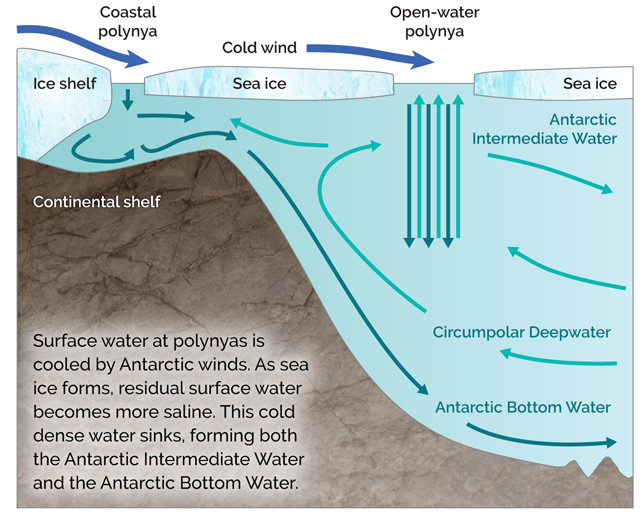
K. Cantner, AGI
Deepwater is also formed along Antarctica’s shallow, continental shelves due to density gradients. Winds blowing off the Antarctic ice sheets push sea ice away from some regions of the coast to form ice-free areas called polynyas. Exposed to the atmosphere, which can be 30 degrees Celsius colder than the ocean, surface waters in these polynyas are chilled and freeze into sea ice. But salt in the seawater doesn’t freeze, instead concentrating in water beneath the ice and causing that water to become more saline, and thus denser. These cold, dense waters then cascade down the continental slope to the seafloor to form a water mass called Antarctic Bottom Water (AABW). In what’s often called a “sea-ice factory,” winds continually push sea ice offshore, prompting the formation of new sea ice and thus new AABW in a cycle of strong vertical convection in the water column. At the ocean bottom, AABW flows north in a layer beneath the NADW, forming the deepest limb of the MOC and filling the deep basins of the Atlantic, Indian and Pacific oceans.
“The formation of deepwater drives the MOC,” Purkey says. And scientists are increasingly thinking that AABW may be the most significant MOC driver.
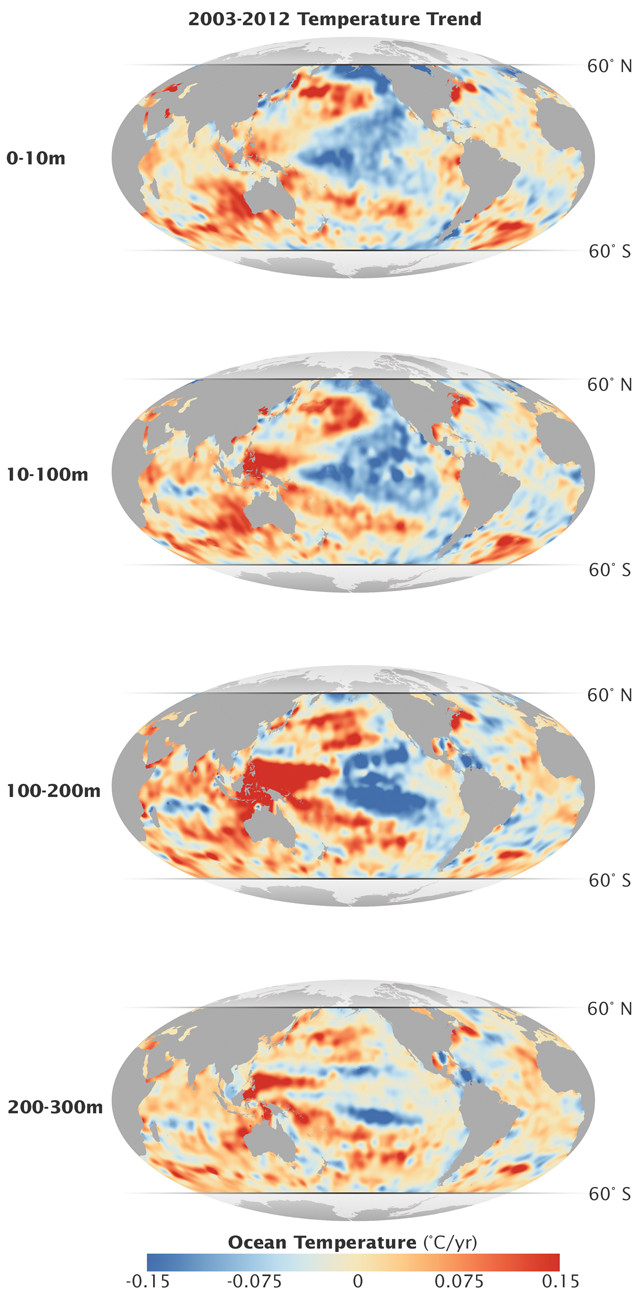
Recent research confirms that the oceans — especially the waters of the Western Pacific and the Indian Ocean — are warming rapidly. But researchers were surprised to find the warming was not predominantly at the surface; instead, the warming was below 10 meters depth, primarily between 100 and 300 meters below the sea surface. Credit: NASA Earth Observatory images by Joshua Stevens, based on a 2015 paper in Science by Nieves et al.
The oceans — especially the North Atlantic and the Southern Ocean — are changing. In the Arctic, sea-ice extent has dramatically decreased in recent decades; 2016 saw the second-lowest annual minimum sea-ice extent on record, and 2017 set a new record for lowest wintertime sea-ice extent. Sea ice acts as insulation between surface waters and the atmosphere; with less sea ice covering the northern waters, surface waters absorb more heat. In addition to impacting sea-surface temperatures, the increase in open-water conditions has been linked with observed shifts in wind and weather patterns in the region.
Recent research also indicates that increasing meltwater flows off the Greenland Ice Sheet are causing freshening in North Atlantic surface waters, which may be weakening the MOC. In a 2015 study published in Nature Climate Change, Stefan Rahmstorf, an oceanographer at the Potsdam Institute for Climate Impact Research in Germany, and his colleagues mapped temperature trends in the North Atlantic and found a significant 20th-century cooling in a region of important deepwater formation south of Greenland. The cold spot anomaly is ongoing today and occurs despite the overall trend of global warming. This feature, Rahmstorf and his colleagues wrote, results from slowed overturning circulation that reduces the heat being pulled northward. And they blame surface freshening from melting Greenland glaciers for the circulation slowdown.
The freshening of surface water impacts deepwater formation because of density gradients. When less-dense freshwater flows from melting glaciers into the ocean surface, it remains at the surface, floating atop the saltier, denser water below. In this scenario, convection and deepwater formation slow, as does the MOC.
Rahmstorf and his colleagues acknowledge that NADW formation and circulation conditions in the North Atlantic are subject to significant natural variability, but they note that human-induced warming is impacting the MOC faster than climate models have typically projected.
In the Southern Ocean, changes also appear to be profound. The Southern Ocean takes up close to half of the anthropogenic heat and carbon dioxide produced on Earth, making it a critical player in regulating global climate. Over the past 50 years, the upper 1,000 meters has warmed faster than the average rate for the rest of the world’s upper ocean. Purkey’s research, based on repeated sampling along several ocean survey lines around the world, indicates that, over the past 30 years, AABW has warmed too. “In addition to warming, AABW also appears to be freshening and decreasing in volume,” she says.
The warming, freshening and decrease in volume of AABW is thought to be linked to an increase in glacial meltwater fluxes into the regions around Antarctica where AABW forms: the Weddell and Ross seas and along the Adélie Coast. Both warmer surface waters and warmer, upwelling deepwater are melting the undersides of ice shelves and glaciers that extend into the seas. Recent studies have looked at the oxygen isotope ratios of the freshening shelf waters in the Ross Sea, a region of high AABW production, and found that most of the freshening is driven by changes in glacial melting on the West Antarctic Peninsula and Amundsen Coast. Ross Sea AABW feeds into the Pacific Ocean, and within the global ocean, “the Pacific is where we’re seeing the strongest bottom-water freshening signal,” Purkey says. This freshening could result in less AABW formation, as the increased density gradient limits deep convection and sinking of surface waters.
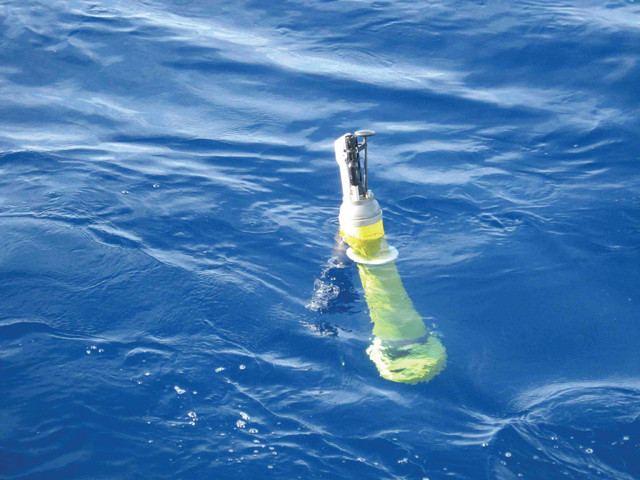
The Argo program, which has deployed thousands of autonomous floats that measure temperature and salinity in the world's oceans, is contributing to data collection efforts. Data from the Argo floats, which can descend to deeper waters, show that abyssal waters are warming. Credit: NASA Earth Observatory.
Outside the Southern Ocean, the deepest abyssal waters along the bottom limb of the MOC, fed by AABW, have also warmed around the planet. “The idea of the abyssal ocean warming is relatively new,” Purkey says. “We thought [abyssal waters] were very isolated on timescales of thousands of years and that we couldn’t see anthropogenic changes. But, in fact, because the Southern Ocean and this deepwater formation region around Antarctica are susceptible to climate change, anthropogenic signatures are being transmitted through the ocean and changing the deep circulation.”
Advection — the transfer of heat through fluid flow — is warming surface waters around the world. But moving this heat from the ocean surface to the bottom of the ocean and spreading it around via advection is a slow process. In a paper published in the Journal of Climate in 2013, Purkey and her co-author, Gregory Johnson, an oceanographer at the University of Washington, found that while advection may be responsible for some of the changes in AABW observed around Antarctica and farther north, another process, called isopycnal heave, is responsible for most of the deep-ocean changes.

Research suggests that a process called isopycnal heave, in which warmer water higher in the water column sinks to fill the space left by a decrease in the formation of cold deepwater, may be responsible for much of the changes observed in AABW. Credit: K. Cantner, AGI.
With less cold deepwater forming and filling the abyssal ocean, warmer water higher in the water column sinks to fill the space. “We are communicating this heat to the deep ocean by producing less AABW as opposed to producing warmer AABW,” Purkey says. And isopycnal heave can communicate heat much faster than advective changes, she says.
What do these changes in AABW mean for the rest of the ocean? The major impact will be on heat storage and sea-level rise, Purkey says. “West Antarctic Ice Sheet melt is contributing, but the entire Southern Ocean is also warming, and that — through thermal expansion [of the ocean water] — is a big contributor to global sea-level rise.” Because changes in deep-ocean waters impact convection and circulation, they will also disrupt the interactions between the ocean and atmosphere, which has major implications for the role the ocean will play in climate change.
Oceans act like massive sponges, with surface waters soaking up heat and dissolved gases such as carbon dioxide from the atmosphere. When these waters are chilled and then sink to form deepwater, the heat and gas are pulled down and stored at depth for centuries. But as global warming slows ocean circulation, the oceans’ ability to suck up and store more heat and carbon dioxide is greatly reduced, says Romanou, whose work on the subject was published in 2017 in Geophysical Research Letters. “By absorbing less heat and less carbon dioxide, the ocean will play a smaller role in helping the earth system deal with climate change associated with anthropogenic emissions,” she says.
Convection and deepwater formation within coastal polynyas of Antarctica have been thought to be the primary source of AABW formation over the past decades. But another process, open-ocean convection farther out at sea, also plays a role in bottom-water formation and deepwater circulation.
The existence of open-ocean convection around Antarctica was discovered in the 1970s when scientists, poring over the trove of images obtained from the recently launched Landsat satellite, noticed something unusual in the frozen Weddell Sea northwest of Antarctica. A massive ice-free area, spanning some 250,000 square kilometers — nearly the size of Texas — was observed, surrounded by the meter-thick ice typical of this seasonally frozen sea. This open-ocean polynya was observed again the following two winters.
Scientists weren’t quite sure what to make of the presence and size of the polynya at the time. Typically, in winter, cold, fresher surface waters of the Southern Ocean overlie warmer, saltier and denser Circumpolar Deepwater (deep waters that combine with relatively warm NADW, flow south, and upwell around Antarctica south of the ACC, closer to the continent). The density gradient between the warm and cold water limits vertical mixing and allows sea ice to develop and persist far offshore the continent.
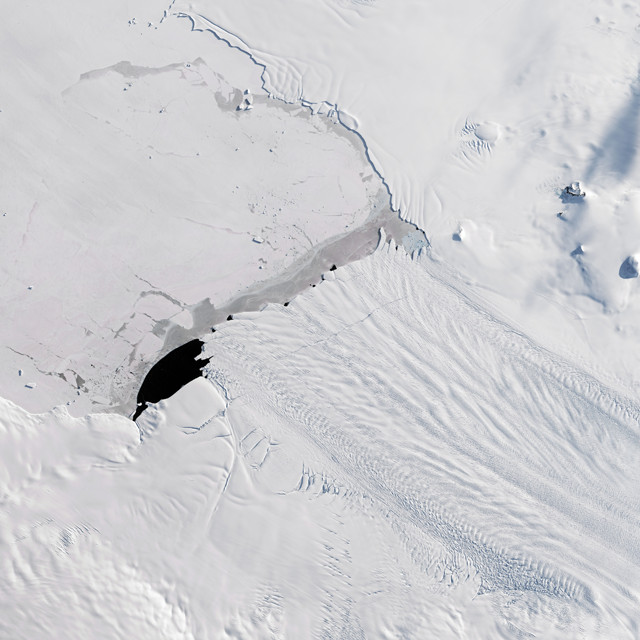
In recent years, huge icebergs have been breaking off the Pine Island Glacier, one of the largest ice streams in Antarctica. (Ice flow direction is from bottom right to top left.) Much AABW forms where the glacier hits the Amundsen Sea (upper left in this image, including dark patch of open water). Last September, an iceberg four times the size of Manhattan calved off the glacier. In this photo, taken two days prior, the rift appears as a faint line to the right of the patch of open water. Credit: NASA Earth Observatory image by Joshua Stevens, using Landsat data from the U.S. Geological Survey.
But data from a 1977 survey in the region showed that the deeper, denser warm water wasn’t there. “I couldn’t believe it,” says Arnold Gordon, an oceanographer at Lamont-Doherty Earth Observatory who was on the cruise that obtained the data. “At first I thought the instrument was broken, but we realized what we were seeing was real, the water at depth really was cold. It became obvious there was deep, open-ocean convection going on.”
Scientists determined that the winter density stratification typically present in the region had broken down for some reason. As a result, deep, warm water rose, melting the sea ice and preventing more from forming. Once at the surface and exposed to the frigid atmosphere, the waters cooled, increased in density and sank in convective overturning that reached down nearly 3,000 meters.
“We knew there was convection along the continental margins of Antarctica, but it seemed that there was major deep-ocean convection happening too,” Gordon says. Scientists hoped this newly discovered connection between the atmosphere and deep ocean could help shed light on a number of outstanding questions about everything from glacial-period atmospheric conditions to the future of heat and gas storage in the ocean.
But, in a puzzling shift scientists are still trying to work out, the polynya disappeared and has not formed on the same massive scale since. What is known is that polynyas — both continental shelf and open-ocean varieties — are conduits that can transmit change happening at the surface to the deep ocean and vice versa. Through the formation of bottom water, polynyas link human influences with the farthest and deepest reaches of the ocean.
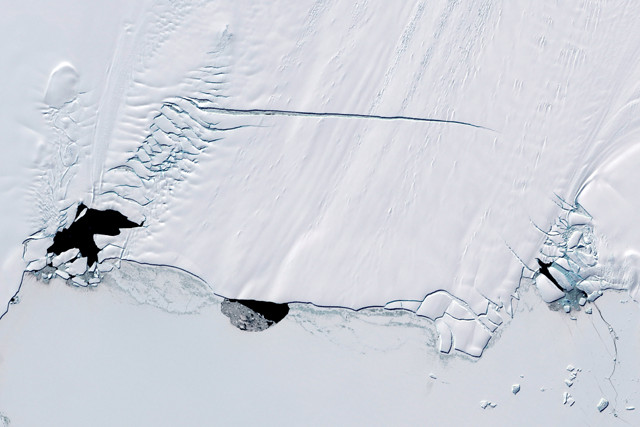
In this image from 2001, three ice-free polynyas can be seen off the Pine Island Glacier. Credit: NASA Earth Observatory image by Robert Simmon, using Landsat data from the U.S. Geological Survey.
In a surprising twist, a small polynya once again appeared in the Weddell Sea during the austral winters of 2016 and 2017 — the first time one has remained open for more than a few weeks since the mid-1970s. Formed over an underwater seamount called the Maud Rise, which can deflect relatively warm Circumpolar Deepwater toward the surface, this polynya was only about 10 percent of the size of the large polynya observed in the late 1970s. But its presence has sparked curiosity in the oceanography community and excitement at the opportunity to further investigate the role polynyas play in ocean circulation. Scientists hope to better understand what their formation — or lack thereof — means for the role of the ocean in future climate change.
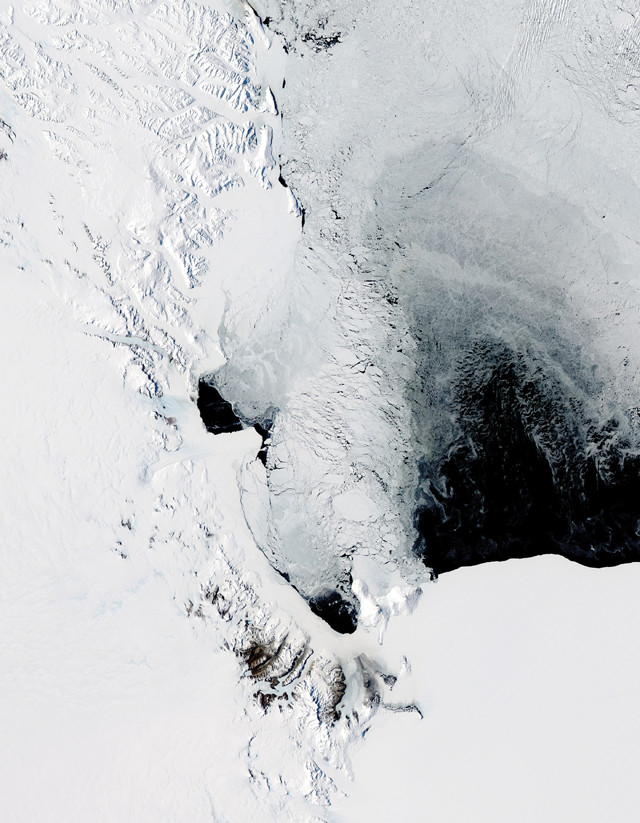
Polynyas — areas of open water amid sea ice — are fairly common in Antarctic coastal regions where winds or upwelling of warmer ocean water can cause the sea ice to move or melt. They are far less common farther offshore. Credit: NASA image courtesy Jeff Schmaltz, LANCE/EOSDIS MODIS Rapid Response Team at NASA GSFC.
Some scientists are beginning to think that offshore polynyas may have been more common in the not-too-distant past and that global warming is to blame for the hydrological changes that are suppressing open-ocean convective activity today.
In a study published in Nature Climate Change in 2014, Casimir de Lavergne, a postdoctoral researcher at the University of New South Wales in Australia, and his colleagues examined 20,000 historical profiles of salinity and temperature conditions in the Southern Ocean; the profiles were collected between 1956 and 2013 south of the ACC but north of the Antarctic continental shelf. They found that surface freshening has considerably enhanced salinity stratification since the 1950s. They also examined climate models to explore the sensitivity of open-ocean deep convection to surface freshening and found that open-ocean convection within the Weddell Sea was probably common under pre-industrial conditions, but that it has become rarer as global temperatures increased.
The long-term freshening of southern polar surface waters is consistent with accelerating melting of Antarctic glaciers. According to de Lavergne’s study, it may also be linked to changes in the Southern Annular Mode (SAM), a north-south oscillation of the westerly wind belt in the Southern Hemisphere. In a positive SAM phase, polar air remains more confined to the Antarctic Ice Sheet, storms of the westerly wind belt reach farther south, more precipitation falls, and the ocean surface becomes fresher and less dense. In a negative SAM phase, cold air spreads seaward from Antarctica, holding back westerly storms. The sea surface then receives less freshwater and becomes saltier, and a denser surface layer forms making open-ocean convection and deepwater formation more likely. A positive SAM phase has prevailed in the region and reduced open-ocean convection over at least the past decade, a condition de Lavergne and others attribute to anthropogenic changes such as stratospheric ozone depletion and rising carbon dioxide concentrations.
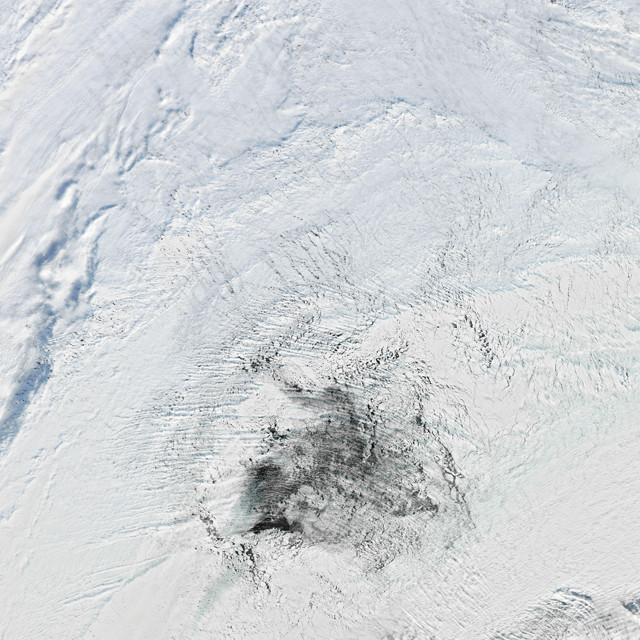
In August 2016, during the austral winter when the Weddell Sea is usually ice-covered, a polynya opened up far from the shoreline, surprising researchers. Credit: NASA Earth Observatory image by Joshua Stevens, using MODIS data from the Land, Atmosphere Near real-time Capability for EOS (LANCE).
With fewer open-ocean polynyas, and thus less open-ocean convection and deepwater formation, we’re likely to see less uptake of heat and carbon dioxide by the ocean, de Lavergne and his colleagues wrote. This could create a positive feedback, feeding further global warming.
Reduced open-ocean convection will affect ocean heat storage in other ways too, Gordon says. Without the insulating effects of sea ice, large-scale polynyas vent an enormous amount of heat into the atmosphere. “But what happens if that communication pipeline gets turned off?” he asks. Instead of being vented to the atmosphere, the heat in deepwater coming from the north stays in the water, spreads farther south toward Antarctica, and may become a factor in the melting of glacial ice around the continent, he says. And this would further the warming, freshening and dwindling production of AABW.
class=““caption”>By connecting the deep-ocean reservoir of carbon and heat to the atmosphere, the Southern Ocean is a major climate regulator. But many questions remain, including about the role of open-ocean polynyas in affecting deepwater formation and heat storage in the Southern Ocean. “We still don’t know if the Southern Ocean is going to be a sink or a source of carbon to the atmosphere,” Purkey says. It’s “a question of how the physics of the Southern Ocean are going to change.”

Researchers with the Southern Ocean Carbon and Climate Observations and Modeling project have deployed about 200 autonomous floats that track climatic effects over the Southern Ocean surface, as well as vertical coverage deep into the water column. Credit: all: SOCCUM, Greta Shum, CC BY 2.0.
With few chances to study offshore polynyas, scientists are keen to jump at opportunities when they do arise. And with the return of polynyas to the Weddell Sea the last couple of years, it’s possible another will form this year.
“If we get a big polynya in the austral winter of 2018, we’re going to learn a lot,” Gordon says. After the lucky break of stumbling upon the polynya in the 1970s, perhaps now, with better tools and an understanding of what to look for, scientists can get a fuller sense of what’s going on in the Southern Ocean and how these features impact heat and gas transfer between the ocean and atmosphere.
Gordon is coordinating efforts to have a ship ready to go south if a polynya does form. But polynya or not, it’s clear from work to date that anthropogenic activity has already altered, perhaps fundamentally, the ways in which the ocean is operating.
© 2008-2021. All rights reserved. Any copying, redistribution or retransmission of any of the contents of this service without the expressed written permission of the American Geosciences Institute is expressly prohibited. Click here for all copyright requests.